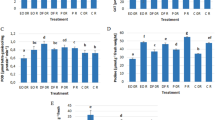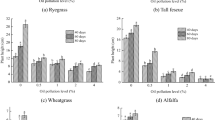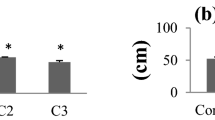Abstract
The first reaction of plants to the presence of the petroleum hydrocarbons in their medium (growth environment) and after the penetration of the contaminants into their tissues is the induction of internal defense mechanisms like enhancing antioxidant enzymes activity, which varies among plant species. The objective of this study was to evaluate the antioxidant enzymes activity and metal ions contents (iron, manganese, and zinc) in broad beans without bacteria and compare the findings with corn at different levels of soil contamination with gasoline (0, 1, 2, 3, and 4%). The main results demonstrated that the activities of superoxide dismutase, peroxidase, and malondialdehyde concentration and the metal ions contents were significantly different between corn and beans. The activities of superoxide dismutase and catalase, concentrations of malondialdehyde and magnesium, and fresh root weight and root length in corn were more significant than the beans. Conversely, peroxidase activity and concentrations of iron and zinc ions in the beans increased. Ultimately, in the absence of bacteria, the corn plant showed superior growth compared to the broad beans under gasoline contamination.










Similar content being viewed by others
References
Adam G, Duncan H (2002) Influence of diesel fuel on seed germination. Environ Pollut 120(2):363–370
Alscher RG et al (2002) Role of superoxide dismutases (SODs) in controlling oxidative stress in plants. J Exp Bot 53(372):1331–1341
Arellano P et al (2015) Detecting the effects of hydrocarbon pollution in the Amazon forest using hyperspectral satellite images. Environ Pollut 205:225–239
Bellout Y (2016) Impact of edaphic hydrocarbon pollution on the morphology and physiology of pea roots (Pisum Sativum L.). Appl Ecol Environ Res 14(2):511–525
Besalatpour A et al (2008) Germination and growth of selected plants in a petroleum contaminated calcareous soil. Soil Sedim Contam 17(6):665–676
Brown DM et al (2017) Heavy hydrocarbon fate and transport in the environment. Q J Eng Geol Hydrogeol 50(3):333–346
Burri J et al (2004) Gasoline composition determined by 1H NMR spectroscopy. Fuel 83(2):187–193
Christeller Laing W J (2004) Extraction of proteins from plant tissues. Curr Protoc Protein Sci 38(1):4.7.1–4.7.7
Devi EL et al (2017) Adaptation strategies and defence mechanisms of plants during environmental stress. Medicinal plants and environmental challenges. Springer, Berlin, pp 359–413
Devienne-Barret F et al (2006) Ara-rhizotron: an effective culture system to study simultaneously root and shoot development of Arabidopsis. Plant Soil 280(1–2):253–266
Du S-T et al (2015) Atmospheric application of trace amounts of nitric oxide enhances tolerance to salt stress and improves nutritional quality in spinach (Spinacia oleracea L.). Food Chem 173:905–911
Fernández-Luqueño F et al (2011) Microbial communities to mitigate contamination of PAHs in soil—possibilities and challenges: a review. Environ Sci Pollut Res 18(1):12–30
FiriAppah C et al (2014) Effects of crude oil spill in germination and growth of Hibiscus Esculentus (Okra) Inbayelsa State Niger Delta Region of Nigeria. Int J Eng Sci 3(6):30–40
Ghalamboran MR (2011) Symbiotic nitrogen fixation enhancement due to magnetite nanoparticles (PhD thesis)
Han G et al (2016) The effects of petroleum-contaminated soil on photosynthesis of Amorpha fruticosa seedlings. Int J Environ Sci Technol 13(10):2383–2392
Issoufi I et al (2006) Seedling growth of agronomic crops in crude oil contaminated soil. J Agron Crop Sci 192(4):310–317
Judd LA et al (2015) Advancements in root growth measurement technologies and observation capabilities for container-grown plants. Plants 4(3):369–392
Kalra Y (1997) Handbook of reference methods for plant analysis. CRC Press, Boca Raton
Khan S et al (2013) Plant–bacteria partnerships for the remediation of hydrocarbon contaminated soils. Chemosphere 90(4):1317–1332
Koushesh Saba M et al (2012) Postharvest polyamine application alleviates chilling injury and affects apricot storage ability. J Agric Food Chem 60(36):8947–8953
Kulkarni SV (2014) Bioremediation of petroleum hydrocarbon polluted sites for the conservation of soil microbial diversity. CSIR-National Chemical Laboratory, Pune
Lakhani A (2018) Polycyclic aromatic hydrocarbons: sources, importance and fate in the atmospheric environment. Curr Org Chem 22(11):1050–1069
Lee S-H et al (2008) Degradation of phenanthrene and pyrene in rhizosphere of grasses and legumes. J Hazard Mater 153(1):892–898
Li X, Yang WL, He H, Wu S, Zhou Q, Yang C, Zeng G, Luo L, Lou W (2018) Responses of microalgae Coelastrella sp. to stress of cupric ions in treatment of anaerobically digested swine wastewater. Bioresour Technol 251:274–279
Liu H et al (2009) An oxidative stress response to polycyclic aromatic hydrocarbon exposure is rapid and complex in Arabidopsis thaliana. Plant Sci 176(3):375–382
Liu R et al (2012) Treatment and remediation of petroleum-contaminated soils using selective ornamental plants. Environ Eng Sci 29(6):494–501
Maliszewska-Kordybach B, Smreczak B (2003) Habitat function of agricultural soils as affected by heavy metals and polycyclic aromatic hydrocarbons contamination. Environ Int 28(8):719–728
Manzetti S et al (2014) Chemical properties, environmental fate, and degradation of seven classes of pollutants. Chem Res Toxicol 27(5):713–737
McCutcheon SC, Schnoor JL (2004) Phytoremediation: transformation and control of contaminants. Wiley, New York
Mendelssohn IA et al (2012) Oil impacts on coastal wetlands: implications for the Mississippi River Delta ecosystem after the Deepwater Horizon oil spill. Bioscience 62(6):562–574
Millaleo R, Reyes-Diaz M, Ivanov AG, Mora ML, Alberdi M (2010) Manganese as essential and toxic element for plants: transport, accumulation and resistance mechanisms. J Soil Sci Plant Nutr 10(4):470–481
Minae-Tehrani D et al (2012) The effect of light crude oil-contaminated soil on the growth and germination of sorghum bicolor. Eur J Plant Sci Biotechnol 6(special issue 1):81–84
Ndimele P (2010) A review on the phytoremediation of petroleum hydrocarbon. Pak J Biol Sci 13(15):715
Ndubuisi Osuagwu A et al (2013) Effect of crude oil pollution on growth parameters, chlorophyll content and bulbils yield in air potato (Dioscorea bulbifera L.). Int J Appl Sci Technol 3(4):37–42
Nwaichi E et al (2014) Distribution of selected carcinogenic hydrocarbon and heavy metals in an oil-polluted agriculture zone. Environ Monit Assess 186(12):8697–8706
Okonokhua B et al (2007) The effects of spent engine oil on soil properties and growth of maize (Zea mays L.). J Appl Sci Environ Manag 11(3):147–152
Panchenko L et al (2018) Dynamics of natural revegetation of hydrocarbon-contaminated soil and remediation potential of indigenous plant species in the steppe zone of the southern Volga Uplands. Environ Sci Pollut Res 25(4):3260–3274
Pawlik M et al (2017) Hydrocarbon degradation potential and plant growth-promoting activity of culturable endophytic bacteria of Lotus corniculatus and Oenothera biennis from a long-term polluted site. Environ Sci Pollut Res 24(24):19640–19652
Pérez-Clemente RM et al (2013) Biotechnological approaches to study plant responses to stress. BioMed Res Int 2013:1–10
Prasad M (2011) A state-of-the-art report on bioremediation, its applications to contaminated sites in India. Ministry of Environment & Forests, Government of India, New Delhi
Rusin M et al. (2015) The effect of petroleum-derived substances on the growth and chemical composition of Vicia faba L. Polish J Environ Stud 24(5):2157–2166
Sharma P et al (2012) Reactive oxygen species, oxidative damage, and antioxidative defense mechanism in plants under stressful conditions. J Bot 2012:1–26
Shi S et al (2005) Protective effect of nitric oxide against oxidative stress under ultraviolet-B radiation. Nitric Oxide 13(1):1–9
Song H et al (2012) Effects of pyrene on antioxidant systems and lipid peroxidation level in mangrove plants, Bruguiera gymnorrhiza. Ecotoxicology 21(6):1625–1632
Tan Y-F et al (2010) Divalent metal ions in plant mitochondria and their role in interactions with proteins and oxidative stress-induced damage to respiratory function. Plant Physiol 152(2):747–761
Ujowundu C et al (2011) Biochemical and physical characterization of diesel petroleum contaminated soil in southeastern Nigeria. Res J Chem Sci 1(8):57–62
Van der Heul R (2011) Environmental degradation of petroleum hydrocarbons (Master’s thesis)
Wyszkowska J et al. (2006) Application of the activity of soil enzymes in the evaluation of soil contamination by diesel oil. Polish J Environ Stud 15(3):501–506
Wyszkowski M, Ziolkowska A (2009) Effect of compost, bentonite and calcium oxide on content of some macroelements in plants from soil contaminated by petrol and diesel oil. J Elementol 14(2):405–418
Wyszkowski M, Ziółkowska A (2008) Effect of petrol and diesel oil on content of organic carbon and mineral components in soil. Am–Eur J Sustain Agric 2(1):54–60
Yakovleva EV et al (2017) Accumulation of PAHs in tundra plants and soils under the influence of coal mining. Polycycl Aromat Compd 37(2–3):203–218
Yang Z, Chu C (2011) Towards understanding plant response to heavy metal stress. In: Abiotic stress in plants-mechanisms and adaptations. InTech
Zhou Q, Lin Y, Li X, Yang C, Han Z, Zeng G, Lu L, He S (2018) Effect of zinc ions on nutrient removal and growth of Lemna aequinoctialis from anaerobically digested swine wastewater. Bioresour Technol 249:457–463
Acknowledgements
This research was carried out in a protected green house and the analysis biomaterials center of plant sciences department, Shahid Behesti University, that is sincerely acknowledged.
Author information
Authors and Affiliations
Corresponding author
Additional information
Editorial responsibility: M. Abbaspour.
Rights and permissions
About this article
Cite this article
Ghalamboran, M.R., Kordkheli, S.S.H. & Bernard, F. Enzymatic response and metal ion content in roots of corn and broad beans planted in soil contaminated with gasoline. Int. J. Environ. Sci. Technol. 17, 973–982 (2020). https://doi.org/10.1007/s13762-019-02406-3
Received:
Revised:
Accepted:
Published:
Issue Date:
DOI: https://doi.org/10.1007/s13762-019-02406-3




